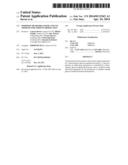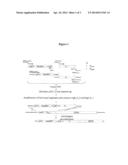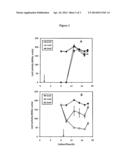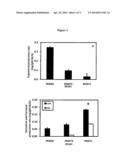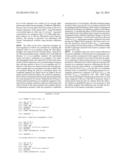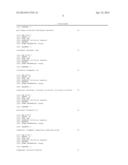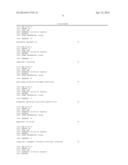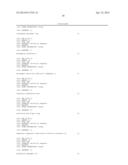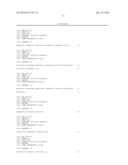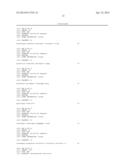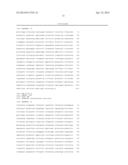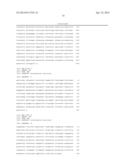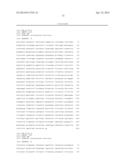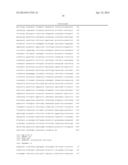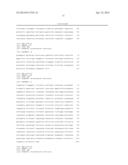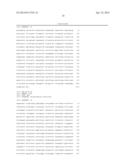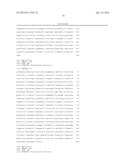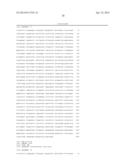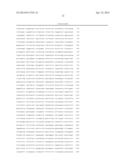Patent application title: MODIFIED MICROORGANISMS AND USE THEREOF FOR TERPENE PRODUCTION
Inventors:
Lauren Daviet (Geneva 8, CH)
Michel Schalk (Geneva 8, CH)
Jens Nielsen (Gothenburg, SE)
Verena Siewers (Goteborg, SE)
Christoph Knuf (Goteborg, SE)
Gionata Scalcinati (Cavenago Bza (milan), IT)
Assignees:
Firmenich SA
IPC8 Class: AC12P502FI
USPC Class:
435166
Class name: Chemistry: molecular biology and microbiology micro-organism, tissue cell culture or enzyme using process to synthesize a desired chemical compound or composition preparing hydrocarbon
Publication date: 2014-04-24
Patent application number: 20140113343
Abstract:
The present invention relates to the control of gene expression by a
heterologous glucose-regulated promoter, to microorganisms in which gene
expression is controlled by a heterologous glucose-regulated promoter and
to methods using said microorganisms for the production of terpenes
during glucose-limited fed-batch fermentation.Claims:
1-22. (canceled)
23. A method for producing a terpene compound comprising cultivating a microorganism expressing at least one terpene synthase and comprising at least one endogenous gene encoding a protein that is not a terpene synthase, wherein i) the native promoter of the endogenous gene has been replaced by a heterologous glucose-regulated promoter; ii) the glucose-regulated promoter is induced by high glucose concentrations and repressed by low glucose concentrations; and iii) the endogenous gene encodes a protein that uses an acylic terpene precursor as substrate; in a glucose-limited fed batch fermentation process, the terpene synthase expressed by said microorganism being capable of catalysing the formation of said terpene compound
24. A microorganism according to claim 23, wherein the microorganism is yeast.
25. The method according to claim 23 wherein the microorganism is selected from yeast of the Saccharomyces, Zygosaccharomyces, Kluyveromyces, Candida, Hansenula, Debaryomyces, Mucor, Pichia and Torulopsis genera.
26. The method according to claim 25, wherein the microorganism is Saccharomyces cerevisiae.
27. The method according to claim 23 wherein the acyclic terpene precursor is geranyl pyrophosphate (GPP), farnesyl pyrophosphate (FPP) or geranyl geranyl pyrophosphate (GGPP).
28. The method according to claim 27, wherein the acyclic terpene precursor is FPP.
29. The method according to claim 26, wherein the protein encoded by the endogenous gene is selected from the group consisting of the prenyl transferases RAM1 and RAM2, the hexaprenyl diphosphate synthase Coq1, the farnesyltransferase COX10, the cis-prenyltranferases SRT1 and RER2 and the squalene synthase ERG9.
30. The method according to claim 23, wherein the protein encoded by the endogenous gene is a squalene synthase.
31. The method according to claim 29, wherein the protein encoded by the endogenous gene is the squalene synthase ERG9.
32. The method according to claims 23 wherein the heterologous glucose-regulated promoter is induced by glucose concentrations of at least 1 gram per litre of culture medium and repressed by glucose concentrations of less than 1 gram per litre of culture medium.
33. The method according to claim 32, wherein the heterologous glucose-regulated promoter is selected from the group consisting of the hexose transporters 1 (HXT1), 3 (HXT3) and 4 (HXT4).
34. The method according to claim 33, wherein the heterologous glucose-regulated promoter is HXT1.
35. The method according to claim 23 wherein the terpene synthase is a monoterpene synthase, a sesquiterpene synthase or a diterpene synthase.
36. The method according claim 35, wherein the terpene synthase is a sesquiterpene synthase.
37. The method according to claim 23, wherein the terpene compound is a monoterpene, a sesquiterpene or a diterpene compound and wherein the terpene synthase is a monoterpene synthase, a sesquiterpene synthase or a diterpene synthase.
38. A method for producing a terpene compound according to claim 37, wherein the terpene compound is a sesquiterpene compound and wherein the terpene synthase is a sesquiterpene synthase.
39. The method according to claim 23 comprising the steps of: a) transforming a microorganism to replace the native promoter of an endogenous gene encoding a protein that uses an acyclic terpene precursor as substrate by a glucose-regulated promoter, said glucose regulated promoter being induced by high glucose concentrations and repressed by low glucose concentrations, provided that said endogenous gene does not encode a terpene synthase and provided that said microorganism further expresses at least one terpene synthase capable of catalysing the formation of said terpene compound; b) cultivating the transformed microorganism obtained in step a) in a glucose-limited fed-batch fermentation process, so that the microorganism produces the terpene compound; and c) optionally isolating the terpene compound produced in step b).
40. The method according to claim 24 comprising the steps of: a) transforming a microorganism to replace the native promoter of an endogenous gene encoding a protein that uses an acyclic terpene precursor as substrate by a glucose-regulated promoter, said glucose regulated promoter being induced by high glucose concentrations and repressed by low glucose concentrations, provided that said endogenous gene does not encode a terpene synthase and provided that said microorganism further expresses at least one terpene synthase capable of catalysing the formation of said terpene compound; b) cultivating the transformed microorganism obtained in step a) in a glucose-limited fed-batch fermentation process, so that the microorganism produces the terpene compound; and c) optionally isolating the terpene compound produced in step b).
41. The method according to claim 25 comprising the steps of:
42. A method for increasing the production of a terpene compound in a microorganism comprising a) transforming the microorganism to replace the native promoter of an endogenous gene encoding a protein that uses an acyclic terpene precursor as substrate by a glucose-regulated promoter, said glucose regulated promoter being induced by high glucose concentrations and repressed by low glucose concentrations, provided that said endogenous gene does not encode a terpene synthase and provided that said microorganism further expresses at least one terpene synthase capable of catalysing the formation of said terpene compound; and b) cultivating the transformed microorganism obtained in step a) in a glucose-limited fed-batch fermentation process, so that the organism produces the terpene compound.
43. A method according to claim 42, wherein the terpene compound is a monoterpene, a sesquiterpene or a diterpene compound and wherein the terpene synthase is a monoterpene synthase, a sesquiterpene synthase or a diterpene synthase.
44. A method according to claim 43, wherein the terpene compound is a sesquiterpene compound and wherein the terpene synthase is a sesquiterpene synthase.
Description:
TECHNICAL FIELD
[0001] The present invention relates to the control of gene expression by a heterologous glucose-regulated promoter, to microorganisms in which gene expression is controlled by a heterologous glucose-regulated promoter and to methods using said microorganisms for the production of terpenes during glucose-limited fed-batch fermentation.
PRIOR ART
[0002] Terpenes are found in most organisms (microorganisms, animals and plants). These compounds are made up of five carbon units called isoprene units and are classified by the number of these units present in their structure. Thus monoterpenes, sesquiterpenes and diterpenes are terpenes containing 10, 15 and 20 carbon atoms respectively. Sesquiterpenes, for example, are widely found in the plant kingdom. Many monoterpene, sesquiterpene and diterpene molecules are known for their flavor and fragrance properties and their cosmetic, medicinal and antimicrobial effects. Over 300 sesquiterpene hydrocarbons and 3,000 sesquiterpenoids have been identified and many new structures are identified each year. Plant extracts obtained by different means such as steam distillation or solvent extraction are used as source of terpenes. Terpene molecules are often used as such, but in some cases chemical reactions are used to transform the terpenes into other high value molecules.
[0003] Biosynthetic production of terpenes involves enzymes called terpene synthases. There is virtually an infinity of terpene synthases present in the plant kingdom, all using acyclic terpene precursors (mainly geranyl pyrophosphate (GPP), farnesyl pyrophosphate (FPP) or geranyl geranyl pyrophosphate (GGPP)) but having different product profiles. Genes and cDNAs encoding terpene synthases have been cloned and the corresponding recombinant enzymes characterized. The biosynthesis of terpenes in microorganisms has been extensively studied and several methods involving modification of the microorganism metabolism in order to increase terpene production have been developed.
[0004] In order to improve sesquiterpene production, several strategies were applied to augment the intracellular pool of the acyclic terpene precursor FPP available for terpene synthases. For example in yeast, as a large part of the FPP produced goes into the sterol producing pathway, several strategies have been developed to reduce the activity of the ERG9 gene, which codes for the squalene synthase (the first committed enzyme in sterol biogenesis).
[0005] Deletion of ERG9 has been envisaged. However, mutants in which ERG9 is deleted are unable to synthesize sterols. Such transformation therefore has the disadvantage that the obtained yeast strains are not viable unless they are fed with sterols.
[0006] In order to avoid deletion of the ERG9 gene, ERG9 mutants with a reduced activity have been used, for example in WO 2010/019696. However, even if the activity of ERG9 is sufficient to avoid sterols feeding, the reduced activity of ERG9 is detrimental to to the yeast growth, the growth being considerably slowed down.
[0007] Another approach was to down-regulate ERG9 by replacing its native promoter by PMET3, a yeast L-methionine regulatable promoter. This strategy has been shown to enhance sesquiterpene production in yeast (Ro et al., Nature 2006, 440:940). However, this method has the disadvantage of requiring supplementing the growth medium with various concentrations of L-methionine depending on the desired level of ERG9 activity. The cost of L-methionine and its possible consumption by the cell constitute important drawbacks of such methods. In particular, the difficulties in controlling the METS promoter activity when the repressing agent L-methionine is metabolized by the cells are evidenced in comparative Example 6 of the present application.
[0008] It is an objective of the present invention to modulate expression of enzymes consuming terpene precursors in microorganisms, for example ERG9, in a way that enables optimal growth of the microorganism as well as maximal selective reduction of the desired gene activity during terpene production and that does not require supplementing the growth medium with additional feeding such as L-methionine or sterols.
SUMMARY OF THE INVENTION
[0009] In a first aspect, the invention provides a microorganism expressing at least one terpene synthase and comprising at least one endogenous gene encoding a protein that is not a terpene synthase, characterized in that
[0010] the native promoter of the endogenous gene has been replaced by a heterologous glucose-regulated promoter;
[0011] said glucose-regulated promoter is induced by high glucose concentrations and repressed by low glucose concentrations; and
[0012] said endogenous gene encodes a protein that uses an acylic terpene precursor as substrate.
[0013] In another aspect, the invention provides a glucose-limited fed batch fermentation process comprising cultivating a microorganism of the invention.
[0014] In a third aspect, the invention provides a method for producing a terpene compound comprising cultivating a microorganism of the invention in a glucose-limited fed batch fermentation process, the terpene synthase expressed by said microorganism being capable of catalysing the formation of said terpene compound.
[0015] In a fourth aspect, the present invention provides a method for increasing the production of a terpene compound in a microorganism comprising:
[0016] a) modifying said microorganism to replace the native promoter of an endogenous gene encoding a protein that is not a terpene synthase and that uses an acyclic terpene precursor as substrate by a glucose-regulated promoter, said glucose regulated promoter being induced by high glucose concentrations and repressed by low glucose concentrations, provided that said microorganism further expresses at least one terpene synthase capable of catalysing the formation of said terpene compound; and
[0017] b) cultivating the transformed microorganism obtained in step a) in a glucose-limited fed-batch process.
BRIEF DESCRIPTION OF THE DRAWINGS
[0018] FIG. 1: Schematic drawing of the cloning strategy for the ERG9 promoter substitution.
[0019] FIG. 2: LacZ activity in strain SCICK10 (PMET3-lacZ) in response to different methionine concentrations, 0 mM (diamond), 1 mM (triangle) and 2 mM (circle), added respectively at 0 hours (A) and 8 hours (B) of cultivation. Arrows represent the time point of methionine addition.
[0020] FIG. 3: Ergosterol production rate (gg biomass-1h-1) (A) and α-(+)-santalene and E,E-farnesol production rate (gg biomass-1h-1) (B) in strains SCICK13 (PERG9), SCICK15 (PMET3) and SCICK12(PHXT1).
DETAILED DESCRIPTION OF THE INVENTION
[0021] The present invention provides a microorganism expressing at least one terpene synthase and comprising at least one endogenous gene encoding a protein that is not a terpene synthase wherein
[0022] the native promoter of the endogenous gene has been replaced by a heterologous glucose-regulated promoter;
[0023] the glucose-regulated promoter is induced by high glucose concentrations and repressed by low glucose concentrations; and
[0024] the endogenous gene encodes a protein that uses an acylic terpene precursor as substrate.
[0025] Any microorganism that can be cultivated in a glucose-containing medium, such as bacteria or yeast, is encompassed by the present invention. Preferably, the microorganism is yeast, more preferably it is selected from yeast of the Saccharomyces, Zygosaccharomyces, Kluyveromyces, Candida, Hansenula, Debaryomyces, Mucor, Pichia and Torulopsis genera. These yeast genera have the advantage of being industrially transformable and cultivable. Even more preferably it is yeast of the Saccharomyces genus and most preferably Saccharomyces cerevisiae.
[0026] For the purpose of the present invention, the microorganism must express at least one terpene synthase. As "terpene synthase" it is intended here any enzyme that is capable of catalysing the transformation of an acyclic terpene precursor into a terpene compound. The terpene compound can be produced as a single product or as part of a mixture of products. Preferably said terpene synthase is a monoterpene synthase (i.e. that is capable of catalysing the transformation of GPP to at least one monoterpene compound), a sesquiterpene synthase (i.e. that is capable of catalysing the transformation of FPP to a sesquiterpene compound) or a diterpene synthase (i.e. that is capable of catalysing the transformation of GGPP to a diterpene compound). Said terpene synthase must be functional, so that the microorganism is capable of catalysing the synthesis of a terpene compound from an acyclic terpene precursor using such terpene synthase. The terpene synthase can be either endogenous or exogenous and can be selected among all terpene synthases as defined above. In particular it can preferably be a monoterpene synthase, a sesquiterpene synthase or a diterpene synthase, more preferably it is a sesquiterpene synthase.
[0027] Examples of preferred sesquiterpene synthases include α-santalene synthase, patchoulol synthase, β-santalene synthase, valencene synthase, cubebol synthase, zizaene synthase, amorpha 4,11-diene synthase, humulene synthase, aristolochene synthase, bergamotene synthase, zingiberene synthase, farnesene synthase, caryophyllene synthase, isodaucene synthase, sesquithujene synthase, avermitilol synthase, eudesmol synthase, vetispiradiene synthase, longifolene synthase, cyclocopacamphene synthase, isolongifolene synthase, germacrene synthase, bicyclogermacrene synthase, bisabolol synthase, germacradienol synthase, hedycaryol synthase, barbatene synthase, epi-cedrol synthase, epi-aristolochene synthase, sesquisabinene synthase, cuprene synthase, selinene synthase, copaene synthase, macrocarpene synthase, cadinol synthase, intermedeol to synthase, nerolidol synthase, muurola-3,5-diene synthase, curcumene synthase and epi-beta santalene synthase. More preferred sesquiterpene synthases include a-santalene synthase, patchoulol synthase, β-santalene synthase, valencene synthase, cubebol synthase, zizaene synthase, amorpha 4,11-diene synthase. Even more preferably, the sesquiterpene synthase is a patchoulol synthase or an a-santalene synthase. Most preferably, it is an α-santalene synthase.
[0028] Examples of preferred diterpene synthases include sclareol synthase, labdendiol synthase and taxadiene synthase. Examples of preferred monoterpene synthases include limonene synthase, pinene synthase, myrcene synthase, camphene synthase, phellandrene synthase, terpinolene synthase, ocimene synthase, linalool synthase, cineole synthase, geraniol synthase, terpinene synthase, fenchol synthase, carene synthase, sabinene synthase.
[0029] The endogenous gene of which the natural promoter is substituted is naturally present in the microorganism and encodes a protein that uses an acyclic terpene precursor as substrate. Such "acyclic terpene precursor" is intended as any precursor that is converted to terpene compounds under the action of a terpene synthase. Preferably it is geranyl pyrophosphate (GPP), farnesyl pyrophosphate (FPP) or geranyl geranyl pyrophosphate (GGPP). Most preferably, the acyclic terpene precursor is FPP.
[0030] As a "protein using an acyclic terpene precursor as substrate" it is intended for the purpose of the present invention any polypeptide that is capable of catalysing a reaction in which an acyclic terpene precursor is the starting material. A variety of genes having such an activity are found in microorganisms. The acyclic terpene precursor can be transformed chemically in different ways, depending on the protein that is involved in its transformation. Such proteins differ from one microorganism to the other. However, such proteins are well-known to the person skilled in the art. Examples of such proteins that can be found for example in yeast include prenyl transferases, farnesyltransferase, cis-prenyltransferase or squalene synthase.
[0031] Any gene that encodes a protein that uses such an acyclic terpene precursor as substrate can be modified for the purpose of the invention. However, said gene must not code for a terpene synthase. This ensures that modification of the gene expression enables to down-regulate the activity of said gene, while maintaining the highest possible activity of terpene synthases expressed by such microorganism.
[0032] In a preferred embodiment of the invention, the promoter-modified gene is a gene to encoding a squalene synthase. For the purpose of the present invention a "squalene synthase" is defined as an enzyme capable of producing squalene from farnesyl pyrophosphate (FPP).
[0033] However, the promoter-modified gene can also be any other gene encoding for a protein that uses an acyclic terpene precursors as substrate. For example, when the microorganism is S. cerevisiae, the endogenous promoter-modified gene can be selected from genes encoding the prenyl transferases RAM1 or RAM2, the protein Coq1, the farnesyltransferase COX10, the cis-prenyltransferases SRT1 or RER2 or the squalene synthase ERG9. Most preferably it encodes ERG9. All of these specific enzymes are endogenous in Saccharomyces cerevisiae and use FPP as substrate.
[0034] The genetic modification of the gene consists in replacing its native promoter by a glucose-regulated promoter that is induced by high glucose concentrations and repressed by low glucose concentrations. For the purpose of the present invention, high glucose concentrations are defined as glucose concentrations of at least 1 gram of glucose per litre of culture medium and low glucose concentration as glucose concentrations below 1 gram of glucose per litre of culture medium. Preferably high glucose concentrations are defined as glucose concentrations of at least 10 grams of glucose per litre of culture medium and low glucose concentration as glucose concentrations below 1 gram of glucose per litre of culture medium.
[0035] The activity of the heterologous promoter is regulated by the concentration of the glucose present in the medium in which the microorganism is cultivated. These concentrations are particularly compatible with the use of the genes of the present invention in microorganisms cultivated in glucose-limited fed-batch fermentation processes, in which such high concentration of glucose are present in the growth medium during the batch phase, thus allowing for high activity of the regulated gene and rapid increase in biomass. Conversely, the promoter provides a reduced level of the regulated protein at low, growth-limiting glucose concentrations, allowing more acyclic terpene precursor, as defined in any of the above-described embodiments, to be utilized for the production of terpene compounds. Concentrations of glucose of less than 1 g per litre of culture medium are compatible with the low amounts of glucose present in the culture medium during the feeding phase of the fed-batch fermentation process because during that phase the glucose feeding is such that all the glucose fed to the medium is consumed by the microorganism, so that the concentration in the medium is close to 0 g/l.
[0036] The glucose-regulated promoter is heterologous. For the purpose of the present invention, a "heterologous promoter" means that in the modified organism such promoter regulates the expression of a gene that it does not regulate in the native microorganism. The promoter can originate from the same microorganism or from another microorganism. In the case where it originates from the same microorganism, it can be responsible for the regulation of the expression of any other gene of said microorganism. In a preferred embodiment, the glucose-regulated promoter originates from the same microorganism or from an organism having a similar philogeny. In a more preferred embodiment, the glucose-regulated promoter originates from the same microorganism.
[0037] Preferred promoters for use in the present invention are promoters that are found naturally in the microorganism in which the gene is present, but which regulate the activity of a different gene. More preferably, the promoter is found in yeast, even more preferably in a yeast of the Saccharomyces genus and most preferably in Saccharomyces cerevisiae. Most preferred promoters for use in the present invention are the hexose transporters 1 (HXT1), 3 (HXT3) and 4 (HXT4). Preferably, it is HXT1. Such promoters are extensively described in J Biol Chem 1999, 274:15350-15359.
[0038] The microorganism can optionally have undergone any other modification of its metabolism, and in particular of its terpene production metabolism. For example its native pathway leading to the formation of the acyclic terpene precursor can have been the object of genetic engineering in order to increase the amount of acyclic terpene precursor produced. As another example, a heterologous pathway leading to the production of such acyclic terpene precursor can have been introduced by genetic engineering into said microorganism. These genetic modifications may include but are not limited to: overexpression of a farnesyl diphosphate synthase (for example ERG20 in S. cerevisiae), overexpression of the catalytic domain of the rate-limiting enzyme 3-hydroxy-3-methylglutaryl-coenzyme A reductase (HMGR), overexpression of upc2-1, a semi-dominant mutant allele that enhances the activity of UPC2, a global transcription factor regulating sterol biosynthesis in S. cerevisiae, deletion of the genes encoding lipid phosphatases active on farnesyl diphosphate (suh as Lpp1 and Dpp1 in S. cerevisiae), deletion of the NADPH-dependent glutamate dehydrogenase encoded by GDH1 and simultaneous overexpression of the NADH-dependent glutamate dehydrogenase encoded by GDH2.
[0039] The microorganisms of the present invention are particularly advantageously cultivated using a glucose-limited fed-batch fermentation process. A glucose-limited fed-batch fermentation process comprising cultivating a microorganism of the invention, as defined in any of the above-described embodiments is therefore another object of the present invention.
[0040] Glucose-limited fed-batch fermentation processes are well-known to the person skilled in the art, so that it needs not be explained extensively in the present description. In any case, examples of conditions that can be applied for such type of fermentation are described in full details in the Examples of the present application. For the purpose of the present invention, a glucose-limited fed-batch fermentation process is intended as any fermentation process in which the microorganism is first grown in a batch phase in the presence of high, non-limiting concentrations of glucose, thus allowing rapid biomass formation, this phase being followed by a feeding phase in which the biomass is cultivated in the presence of low, growth-limiting glucose concentrations. Preferably, the concentration of glucose in the culture medium used in the batch phase is of at least 1 g/l, more preferably at least 10 g/l whereas the concentration of glucose in the culture medium used in the feeding phase is of less than 1 g/l.
[0041] The microorganism of the present invention, as defined in any of the above-described embodiments is also advantageously used in a method for producing a terpene compound comprising cultivating a microorganism of the invention in a glucose-limited fed batch fermentation process, as defined above. In such method the terpene synthase expressed by the microorganism is capable of catalysing the formation of the terpene compound that is intended to be produced. Such terpene synthase is as defined above in any embodiment of the invention. Most preferably, it is a sesquiterpene compound. Examples of sesquiterpene compounds include a-santalene, patchoulol, β-santalene, valencene, cubebol, zizaene, amorpha 4,11-diene, humulene, aristolochene, bergamotene, zingiberene, farnesene, caryophyllene, isodaucene, sesquithujene, avermitilol, eudesmol, vetispiradiene, longifolene, cyclocopacamphene, isolongifolene, germacrene, bicyclogermacrene, bisabolol, germacradienol, hedycaryol, barbatene, epi-cedrol, epi-aristolochene, sesquisabinene, cuprene, selinene, copaene, macrocarpene, cadinol, intermedeol, nerolidol, muurola-3,5-diene, curcumene and epi-beta santalene. More preferred sesquiterpene include a-santalene, patchoulol, β-santalene, valencene, cubebol, zizaene, amorpha 4,11-diene. Even more preferably, the sesquiterpene is to patchoulol or a-santalene. Most preferably, it is α-santalene.
[0042] Examples of preferred diterpenes include sclareol, labdendiol and taxadiene. Examples of preferred monoterpenes include limonene, pinene, myrcene, camphene, phellandrene, terpinolene, ocimene, linalool, cineole, geraniol, terpinene, fenchol, careen and sabinene.
[0043] In a preferred embodiment of the invention, the method for producing a terpene compound comprises the following steps:
[0044] a) transforming a microorganism to replace the native promoter of an endogenous gene encoding a protein that uses an acyclic terpene precursor as substrate by a glucose-regulated promoter, said glucose regulated promoter being induced by high glucose concentrations and repressed by low glucose concentrations, provided that said gene does not encode a terpene synthase and provided that said microorganism further expresses at least one terpene synthase capable of catalysing the formation of said terpene compound;
[0045] b) cultivating the transformed microorganism obtained in step a) in a glucose-limited fed-batch fermentation process, so that the microorganism produces the terpene compound; and
[0046] c) optionally isolating the terpene compound produced in step b)
[0047] In another embodiment, the invention provides for a method for increasing the production of a terpene compound in a microorganism comprising:
[0048] a) transforming said microorganism to replace the native promoter of an endogenous gene encoding a protein that uses an acyclic terpene precursor as substrate by a glucose-regulated promoter, said glucose regulated promoter being induced by high glucose concentrations and repressed by low glucose concentrations, provided that said gene does not encode a terpene synthase and provided that said microorganism further expresses at least one terpene synthase capable of catalysing the formation of said terpene compound; and
[0049] b) cultivating the transformed microorganism obtained in step a) in a glucose-limited fed-batch fermentation process so that the microorganism produces the terpene compound.
[0050] In such method, the microorganism, the terpene compound, the gene, the promoter and the terpene synthase are all as defined in any of the above-described embodiment of the invention.
EXAMPLES
Example 1
ERG9 Promoter Replacement by the MET3 Promoter (Comparative Example)
[0051] The MET3 promoter was amplified from genomic DNA of S. cerevisiae CEN.PK 113-7D (MATa MAL2-8c SUC2 ura3-52) (BMC Genomics 2010 11:723) using the primers 1 and 2 (SEQ ID NO:1 and SEQ ID NO:2). The PCR conditions were in accordance with the Expand High Fidelity standard conditions (Roche Applied Science, Mannheim, Germany). Subsequently, the PCR fragments were digested by the restriction enzymes SpeI and SacII. In parallel, pUG6 plasmid (Nucleic Acids Res 1996, 24:2519-2524) was digested by the same couple of restriction enzymes. The DNA fragments were separated by gel electrophoresis and gel purified using the QIAEX1 II Gel extraction kit (Qiagen, Hilden, Germany). In vitro ligation of the digested plasmid with the digested PCR products was performed as the standard procedure given for T4 DNA ligase (Roche Applied Science). The resulting ligation mixture was used to transform chemically competent E. coli cells (DH5α) (Gene 1990, 96:23-28). Transformants were selected on LB medium supplemented with ampicillin (50 mg/L). The plasmid obtained was named pIP007.
[0052] The ERG9 gene is designated as YHR190W within the genome of CEN.PK 113-7D, as published in BMC Genomics 2010 11:723. The amino acid sequence of ERG9 encoded by this nucleic acid is published in GenBank, accession number: AAA34597.
[0053] In order to replace the native ERG9 promoter by the MET3 promoter, fusion PCR and a bipartite gene targeting method (Genome Res 1997, 7:1174-1183) were used. Four fragments were separately amplified before fusing them together in pairs. First, two fragments containing the MET3 promoter and the KanMX selection cassette were amplified from pIP007 in two separate, but overlapping fragments using the two couples of primers: primers 3 and 4 (SEQ ID NO:3 and 4) (Fragment A (SEQ ID NO:35)) and primers 5 and 6 (SEQ ID NO:5 and 6) (Fragment B (SEQ ID NO:36)). Furthermore, 500 by upstream of the ERG9 promoter in the genome of S. cerevisiae CEN.PK 113-7D (BMC Genomics 2010 11:723) were amplified using primers 7 and 8 (SEQ ID NO:7 and 8) (Fragment C (SEQ ID NO:37)). The first 500 by of the ERG9 ORF were as well amplified using primers 9 and 10 (SEQ ID NO:9 and 10) (Fragment D (SEQ ID NO:38)). The resulting four PCR fragments were gel-purified using the High Pure PCR Product Purification kit (Roche Applied Science) and subsequently fused together in pairs using fusion PCR. Fused fragments A and C (SEQ ID NO:39) were obtained after a fusion PCR using primers 4 and 7 (SEQ ID NO:4 and 7) while fused fragments B and D (SEQ ID NO:40) were obtained after a fusion PCR using primers 5 and 10 (SEQ ID NO:5 and 10). The two final fusion PCR fragments were gel purified with the High Pure PCR Product Purification kit.
[0054] S. cerevisiae strain CEN.PK113-5D (BMC Genomics 2010 11:723) was transformed with the obtained fusion PCR fragments to result in strain YIP-M0-04 (MATa MAL2-8c SUC2 ura3-52 PERG9Δ::kanMX-PMET3). The loxP flanked kanMX cassette in strain YIP-M0-04 was then excised with the help of the Cre recombinase expression plasmid pSH47 as described by Guldener et al. (Nucleic Acids Res.--1996, 24:2519-2524).
[0055] To prevent the conversion of the isoprenoid precursor farnesyl pyrophosphate (FPP) into farnesol, the FPP phosphatase LPP1 (GenBank NM--001180811.1) was deleted in the YIP-M0-04 strain using a bipartite gene targeting strategy (J Biol Chem. 1999, 274:14831-14837; Genome Res 1997, 7:1174-1183). The 5' and 3' region of the LPP1 gene were amplified by PCR using primer pairs 11/12 (SEQ ID NO:11 and 12) (fragment 1 (SEQ ID NO:41)) and 13/14 (SEQ ID NO:13 and 14) (fragment 2 (SEQ ID NO:42)), respectively, and genomic DNA of CEN.PK113-5D as template (BMC Genomics. 2010 11:723). The 5' and the 3' part of the kanMX cassette were amplified from plasmid pUG6 using primer pairs 15/16 (SEQ ID NO:15 and 16) (fragment 3 (SEQ ID NO:43) and 17/18 (SEQ ID NO:17 and 18) (fragment 4 (SEQ ID NO:44)), respectively. Complementary primer tails allowed for the combination of fragments 1 and 3 (SEQ ID NO:45) by fusion PCR. Likewise, fragments 2 and 4 (SEQ ID NO:46) were fused to each other. Cells were transformed with both fusion PCR fragments and integration of the kanMX cassette at the LPP1 locus was tested by PCR using primers 19 and 20 (SEQ ID NO:19 and 20). Subsequent excision of the kanMX cassette led to formation of strain SCICK00 (MATa MAL2-8c SUC2 ura3-52 dpp1Δ::loxP PERG9Δ::loxP-PMET3).
Example 2
Construction of a PMET3 Reporter Strain
[0056] To construct an integrative plasmid carrying the reporter gene LacZ under the control of the MET3 promoter, the latter was amplified from genomic DNA of S. cerevisiae CEN.PK 113-7D using the primers 1' and 2' (SEQ ID NO:33 and 34), restricted with HindIII/NotI and ligated into HindIII/NotI cut pSF011 plasmid resulting in pSF011-PMET3 (Yeast 2010, 27: 955-964). A yeast strain carrying a genomic integration of LacZ under the control of the MET3 promoter was constructed by transforming CEN.PK 113-7D with the NcoI restricted integrative plasmid pSF011-PMET3 resulting in strain SCICK10 (MATa MAL2-8c SUC2 ura3-52::pSF011-PMET3).
Example 3
ERG9 Promoter Substitution by the HXT1 Promoter
[0057] The strain described above was used for further promoter substitutions using the strategy depicted in FIG. 1.
[0058] To replace the ERG9 controlling MET3 promoter in SCICK00, the ERG9 promoter and the HXT1 promoter were amplified from CEN.PK113-5D genomic DNA by PCR using primer pairs 21/22 (SEQ ID NO:21 and 22) and 23/24 (SEQ ID NO:23 and 24), respectively. In addition the kanMX cassette was amplified in a PCR reaction containing primers 25 and 26 (SEQ ID NO:25 and 26). The marker cassette was combined with either of the two promoters by fusion PCR and the resulting fragments were amplified once more using primers 27 and 28 (SEQ ID NO:27 and 28) in order to extend the flanking regions for genomic integration (ERG9 fusion (SEQ ID NO:47) and HXT1 fusion fragments (SEQ ID NO:48). After successful fusion, the fragments were cloned into pJET1.2 (Fermentas GMBH) and sequenced. Transformation of SCICK00 with these fusion PCR fragments and subsequent excision of the kanMX cassette resulted in strains SCICK01 (MATa MAL2-8c SUC2 ura3-52 dpp1Δ::loxP PERG9Δ::loxP-PHXT1) and SCICK03 (MATa MAL2-8c SUC2 ura3-52 dpp1Δ::loxP PERG9Δ::loxP-PERG9).
Example 4
Construction of an (+)-α-Santalene and tHMG1 Yeast Expression Vector
[0059] To construct the (+)-α-santalene expression vector, the santalene synthase cDNA was amplified by PCR from plasmid Cont2B-27-pET101 (WO 2009109597, GenBank accession number: HQ452480), using primers 29 and 30 (SEQ ID NO:29 and 30), cut with NotI/PacI and ligated into NotI/PacI restricted vector pSP-G1 (Yeast 2010, 27:954-965). Subsequently, tHMG1 was PCR amplified using genomic DNA of S. cerevisiae CEN.PK113-5D as template and primers 31 and 32 (SEQ ID NO:31 and 32), cut with BamHI/NheI and ligated into the same vector after restriction with BamHI and NheI (Nature 2006, 440:940-943). This resulted in formation of the expression plasmid pICK01. pICK01 was then transformed in SCICK00, SCICK01 and SCICK03 resulting in strains SCICK12 (MATa MAL2-8c SUC2 ura3-52 dpp1Δ::loxP PERG9Δ::loxP-PHXT1), SCICK13 (MATa MAL2-8c SUC2 ura3-52 dpp1Δ::loxP PERG9Δ::loxP-PERG9) and SCICK15 (MATa MAL2-8c SUC2 ura3-52 dpp1Δ::loxP PERG9Δ::loxP-PMET3), respectively.
Example 5
Glucose-Limited Fed Batch Cultivation
[0060] For batch cultivations, a previously described (Yeast 1992, 8:501-517) mineral salts medium was used consisting of the following: (NH4)2SO4 (5 g/l); KH2PO4 (3 g/l); MgSO4.7H2O (0.50 g/l); Antifoam 289 (Sigma-Aldrich) (0.050 ml/l); trace metals (1 ml/l) and vitamins 1.0 ml/l. The trace metal solution consisted of the following: EDTA (sodium salt) (15.0 g/l); ZnSO4.7H2O (0.45 g/l); MnCl2.2H2O (1 g/l); CoCl2.6H2O (0.3 g/l); CuSO4.5H2O (0.3 g/l); Na2MoO4.2H2O (0.4 g/l); CaCl2.2H2O (0.45 g/l); FeSO4.7H2O (0.3 g/l); H3BO3 (0.1 g/l) and KI (0.10 g/l). The pH of the trace metal solution was adjusted to 4.0 with 2M NaOH prior to heat sterilization. The vitamin solution consisted of the following: biotin (0.05 g/l); p-amino benzoic acid (0.2 g/l); nicotinic acid (1 g/l); Ca-pantothenate (1 g/l); pyridoxine-HCl (1 g/l); thiamine-HCl (1 g/l) and myo-inositol (25 g/l). The pH of the vitamin solution was adjusted to 6.5 with 2M NaOH. The vitamin solution was filter sterilized and stored at 4° C. This medium was supplemented with 30 g/l glucose. The feed composition used for fed-batch cultivation had the same composition as described above, but the (NH4)2SO4; KH2PO4; MgSO4.7H2O, vitamin solution, and trace metal solution, concentration were increased 10 times. The glucose concentration was 200 g/l.
[0061] The seed cultures for the cultivations were grown at 30° C. in 500 ml shake flasks containing 100 ml of culture with agitation in an orbital shaker at 100 rpm. Per-cultures were used to inoculate the fermentors to a final dry weight of 1 mg/l.
[0062] The aerobic fed-batch process was performed in 2.5 liter Applikon vessels (Applikon, Schiedam, the Netherlands) with a working volume of 1.0 liter. Agitation at 600 rpm was maintained using an integrated magnetic stirrer (DasGip, Julich, Germany) and the temperature kept at 30° C. The rate of aeration was set to 0.61/min. The pH of the medium was maintained at 5.0 by automatic addition of 2 N KOH during the batch phase and 10% NH4OH during the feed phase. The temperature, agitation, gassing, pH and composition of the off-gas were monitored and controlled using the DasGip monitoring and control system. Dissolved oxygen concentration was monitored with a polarographic oxygen electrode (Mettler Toledo, Columbus, Ohio, USA) and kept above 30% via stirrer speed and gas flow rate using the DasGip control system. The effluent gas from the fermentation was analyzed for real-time determination of oxygen and CO2 concentrations by DasGip fedbatch pro® gas analysis systems with the off gas analyzer GA4 based on zirconium dioxide and two-beam infrared sensor.
[0063] The fed-batch cultures were initiated as batch culture using 30 g/l glucose, feeding with fresh medium commenced only after residual ethanol produced from the glucose consumption phase was completely depleted. A feed strategy was designed keeping the volumetric growth rate constant. An exponential feed rate v(t) (1/h) was calculated according to the following equation:
v ( t ) = Y xs μ 0 s f - s 0 x 0 V 0 exp ( μ 0 t ) ##EQU00001##
where x0, s0 and V0 were the biomass density (g DCW/l), the substrate concentration (g/l) and the reactor volume (1) at the start of the fed-batch process, Yxs was the respiratory yield coefficient (g glucose/g DCW); sf was the concentration of the growth limiting substrate (g glucose/l) in the reservoir; μ0 was the specific growth rate (h-1) during the feed phase and t the feeding time expressed in hours. According to the equation above, the feed was increased exponentially with a specific feed rate of 0.06 h-1. Correct feed rate addition was obtained programming the fermentor fb-pro software (DasGip) and controlled using the DasGip control system. Under the feeding conditions, the glucose concentrations in the fermentor are maintained under 1 g/L allowing a repression of ERG9 expression. An organic layer of dodecane (Sigma-Aldrich St. Louis, Mo.) was added aseptically to a final volume of 10% (v/v) immediately before starting the feed.
Example 6
Functional Characterization of the MET3 Promoter (Comparative Example)
[0064] The level of repression of the MET3 promoter throughout batch cultivation was determined by fusing PMET3 to the LacZ reporter gene followed by measuring the β-galactosidase activity as described earlier (Yeast 2009, 26:545-551). In previous studies, PMET3-LacZ exhibited different levels of expression depending on the concentration of methionine supplied (Curr Microbiol 2002, 45:37-40). In order to evaluate the correct supply of methionine required to reduce the LacZ expression, strain SCICK10 was cultivated in shake flasks without L-methionine, with 1 mM and 2 mM L-methionine as initial concentration, and with 1 mM and 2 mM L-methionine added when the cultures had reached an OD600 of 0.6. The concentrations of the inhibitor were chosen based on the amounts previously used for ERG9 repression (Biotechnol Bioeng 2007, 993:666-677). As shown in FIG. 2A, the β-galactosidase activity was constant in the cultures not containing L-methionine. In the cultures that contained L-methionine from the beginning, LacZ activity was initially very low. However, at about mid-exponential phase, it started to increase and rapidly reached the levels measured in the non-repressed culture. When L-methionine was added at a later stage, LacZ activity dropped to a lower level in the culture pulsed with 2 mM L-methionine than in the culture pulsed with 1 mM L-methionine, but in both cases it started to increase again towards the end of the cultivation (FIG. 2B).
[0065] These results demonstrate the difficulties in controlling the MET3 promoter activity when the repressing agent is metabolized by the cells. We therefore tested, if D-methionine or 2-hydroxy-4-(methylthio)butyric acid could serve as L-methionine analogues to repress the PMET3 promoter, because they may not be metabolized by yeast or metabolized to a lesser extent. At concentrations of up to 4 mM in the medium neither of the two compounds had the capability to reduce PMET3 activity (data not shown). These results confirm the interest of finding an alternative solution to the regulation of gene activity using the MET3 promoter.
Example 7
Evaluation of the HXT1 Promoter to Control ERG9 Expression in Fed Batch Fermentation
[0066] Three strains were constructed. Strain SCICK13 in which ERG9 is under the control of its native promoter served as a reference strain. In strains SCICK15 and SCICK12, the ERG9 promoter had been replaced by the MET3 and HXT1 promoter, respectively. In order to maintain ERG9 repressed in the SCICK15 culture during the fermentation, L-methionine was added at regular interval every 6 hours to a final concentration of 2 mM.
[0067] All strains carried a deletion in the phosphatase encoding LPP1 gene to reduce the loss of FPP to farnesol (J Biol Chem 1999, 274:14831-14837). tHMG] and (+)-α-santalene synthase were expressed from a high copy plasmid under control of the PGK1 and TEF1 promoters, respectively.
[0068] The physiological characterization of the strains was completed in aerobic glucose limited fed batch culture. A fed batch in situ product removal (ISPR) reactor mode consisting in an aqueous/dodecane two phase partitioning system was chosen to evaluate the (+)-α-santalene production capacity of these strains engineered to accumulate FPP. (+)-α-santalene production during the course of fermentation was determined as described previously in Biotechnol Bioeng 2010, 106:86-96. Samples from the organic layer were centrifuged 5 minutes at 5000 g and the supernatants were analyzed by gas chromatography-mass spectrometry (GC/MS) with a DSQ II single quadrupole mass spectrometer (Thermo Scientific, Waltham, Mass.). Analytes from 1 μl sample were separated on a SLB-5 ms capillary column (15 m, 0.25 mm i.d., 0.25 μm film thickness; Supelco, Bellefonte, Pa., USA) using helium as carrier gas at a flow rate of 1.2 ml min-1. A split/splitless injector was used in the splitless mode. The initial oven temperature was 80° C. and the injector temperature was 250° C. The oven temperature was increased to 120° C. at a rate of 10° C./min and subsequently increased to 160° C. at a rate of 3° C./min. The oven temperature was finally increased to 270° C. at a rate of 10° C./min and held for 5 minutes at this temperature. Full mass spectra were generated by scanning m/z range within 40-500 for metabolite identification. Quantification of (+)-a-santalene and E,E-farnesol was carried out using standard curves.
[0069] For the extraction of sterols, a previously described method (Biotechnol Bioeng 2010, 106:86-96) was used with minor modifications. Known volumes of fermentation broth were harvested by centrifuging at 5,000 rpm for 10 minutes. The cell pellet was washed twice with distilled water and the cell suspension was centrifuged for another 10 minutes at 5,000 rpm. The cell pellet was resuspended in 4 ml of 0.2 N HCl and heated in a water bath at 85° C. for 1 h and then allowed to cool to room temperature. After centrifugation for 10 minutes at 5,000 rpm and removal of the supernatant, the cell pellet was resuspended in 2 nil methanol containing 0.2% (w/v) pyrogallol and 1 ml 4 N KOH and transferred to a 14 ml glass vial sealed with a PTFE lined screw cap, heated again for 2 hours in a water bath at 85° C. for saponification and then cooled to room temperature. Sterols were extracted by addition of 5 ml heptane followed by vigorous mixing for 2 minutes. After 2 hours, the n-heptane layer was transferred to a new glass vial for HPLC analyses. Quantitative determination of total ergosterol was carried out by isocratic high-performance liquid chromatography (UltiMate® 3000 Nano, Dionex) with a reverse phase Develosil column (C30-UG-5; Nomura Chemicals, Aichi, Japan) at 40° C. using 70% MeOH as the mobile phase at a flow rate of 1 nil min-1. Ergosterol concentration was measured with a UV-visible light absorbance detector set at 280 nm (Photodiode Array Detector, Dionex). The amount of ergosterol was determined with Dionex Chromeleon® software using absolute calibration curves.
[0070] The effect of the above mentioned strategies for down-regulation of ERG9 was evaluated by comparing the obtained yield of (+)-α-santalene during the feed phase. Samples were taken from the dodecane phase, analysed by GC-MS and quantified using a standard curve with different dilutions of a (+)-α-santalene standard. All transformed strains were able to synthesize (+)-α-santalene. Two major chromatographic peaks were detected in all the strains transformed with the expression vector corresponding in retention time and mass spectra to those of (+)-α-santalene and E,E-farnesol. Cultivation was started as batch with 30 g/l glucose. After complete glucose consumption and after residual ethanol produced during the glucose consumption phase was completely depleted, the organic layer was added to the fermentor and the production phase was started by initiating a feed of fresh concentrated substrate with exponential kinetics for a total feed period of 36 hours. Within the first 30 hours of feed the culture metabolism was completely respiratory characterized by complete oxidation of glucose with biomass and carbon dioxide as the major products and complete absence of fermentation products, while the respiratory coefficients remained close to 1 for all strains. After that a limitation phase occurred where yeast growth was no longer consistent with the feeding profile determining a shift towards a fermentative metabolism resulting in accumulation of glucose and ethanol production. To examine the effect of ERG9 repression on the sterol pathway the total cellular sterol content was measured. Engineered strains exhibited significant changes in the level of ergosterol production. A lower sterol content was observed in the two PERG9 replacement mutants compared to the strain bearing the original ERG9 promoter. The lowest sterol content was observed in strain SCICK12 (PHXT1) (microorganism according to the invention) with a 11-fold reduction while the MET3 promoter (strain SCICK15) led to a modest 3-fold decrease (FIG. 3A).
[0071] To establish if the lower sterol content reflected an increased availability of FPP precursor for sesquiterpene conversion, product accumulation in the organic layer was measured. A linear correlation was observed between the reduction in ergosterol content and the increase in (+)-α-santalene production. Different levels of ERG9 repression diverted FPP towards (+)-α-santalene formation, redirecting the flux distribution from the sterol pathway to sesquiterpene production. Strain SCICK12 (PHXT1) was the best (+)-α-santalene producer with a 3.4-fold and 2.3-fold improvement in (+)-α-santalene productivity compared to SCICK13 (PERG9) and SCICK15 (PMET3), respectively (FIG. 3B). These results show that the advantages of the present invention are two-fold when compared to the use of the MET3 promoter, which is already known from the prior art. Indeed, firstly the cultivation method is simplified because it is not necessary to feed the culture medium with methionine and secondly the production rate of the terpene compound is increased.
Sequence CWU
1
1
48136DNAArtificial sequencePrimer 1ggactagtcc ttggtataag gtgagggggt ccacag
36238DNAArtificial sequencePrimer
2tccccgcggg gagaatacca ccgtgaggag caggcatg
38340DNAArtificial sequencePrimer 3gatccccggg aattgccatg acgctgcagg
tcgacaaccc 40423DNAArtificial sequencePrimer
4ccatgagtga cgactgaatc cgg
23523DNAArtificial sequencePrimer 5ctatcgattg tatgggaagc ccg
23659DNAArtificial sequencePrimer
6caatgccaat tgtaatagct tcccatgtta attatacttt attcttgtta ttattatac
59722DNAArtificial sequencePrimer 7agcctcagta cgctggtacc cg
22845DNAArtificial sequencePrimer
8catggcaatt cccggggatc tgggctatga aatgtactga gtcag
45927DNAArtificial sequencePrimer 9atgggaaagc tattacaatt ggcattg
271022DNAArtificial sequencePrimer
10gtcgtagtcg tggacggttt gc
221120DNAArtificial sequencePrimer 11aaggatgatc tctgtcatgg
201240DNAArtificial sequencePrimer
12gatccccggg aattgccatg tgttagggca gcatttatgc
401342DNAArtificial sequencePrimer 13gcagggatgc ggccgctgac gcactccaag
cggacattca ag 421420DNAArtificial sequencePrimer
14gaagtatgtc tcttttcgcc
201549DNAArtificial sequencePrimer 15catggcaatt cccggggatc cccttaatat
aacttcgtat aatgtatgc 491623DNAArtificial sequencePrimer
16ccatgagtga cgactgaatc cgg
231721DNAArtificial sequencePrimer 17gcaaaggtag cgttgccaat g
211841DNAArtificial sequencePrimer
18gtcagcggcc gcatccctgc cgactcacta tagggagacc g
411925DNAArtificial sequencePrimer 19tagttgccac gtgaaacctg acaac
252025DNAArtificial sequencePrimer
20aatttcatcg gtattttggc ttcgg
252152DNAArtificial sequencePrimer 21cgaagttatt aggtgatatc agatccactg
cccatcttca acaacaatac cg 522222DNAArtificial sequencePrimer
22gtcgtagtcg tggacggttt gc
222356DNAArtificial sequencePrimer 23cgaagttatt aggtgatatc agatccactt
gcaggtctca tctggaatat aattcc 562483DNAArtificial sequencePrimer
24gctgccttca tctcgaccgg atgcaatgcc aattgtaata gctttcccat gattttacgt
60atatcaacta gttgacgatt atg
832571DNAArtificial sequencePrimer 25gagtgaacct gctgcctggc gtgctctgac
tcagtacatt tcatagccca gtacgctgca 60ggtcgacaac c
712629DNAArtificial sequencePrimer
26agtggatctg atatcaccta ataacttcg
292733DNAArtificial sequencePrimer 27ccttgcttac acagagtgaa cctgctgcct ggc
332832DNAArtificial sequencePrimer
28cttcagcttc aaagctgcct tcatctcgac cg
322945DNAArtificial sequencePrimer 29gttgttgcgg ccgcaaaaca atgtcaactc
aacaagtttc atcag 453035DNAArtificial sequencePrimer
30gttgttttaa ttaactaatc gtcaagctta acggg
353134DNAArtificial sequencePrimer 31gttgttgcta gcttaggatt taatgcaggt
gacg 343220DNAArtificial sequencePrimer
32ggttccgcgc acatttcccc
203335DNAArtificial sequencePrimer 33caacaaaagc ttgtataagg tgagggggtc
cacag 353452DNAArtificial sequencePrimer
34caacaaggcg gccgcgttaa ttatacttta ttcttgttat tattatactt tc
52351061DNASaccharomyces cerevisiae 35gatccccggg aattgccatg acgctgcagg
tcgacaaccc ttaatataac ttcgtataat 60gtatgctata cgaagttatt aggtctagag
atctgtttag cttgcctcgt ccccgccggg 120tcacccggcc agcgacatgg aggcccagaa
taccctcctt gacagtcttg acgtgcgcag 180ctcaggggca tgatgtgact gtcgcccgta
catttagccc atacatcccc atgtataatc 240atttgcatcc atacattttg atggccgcac
ggcgcgaagc aaaaattacg gctcctcgct 300gcagacctgc gagcagggaa acgctcccct
cacagacgcg ttgaattgtc cccacgccgc 360gcccctgtag agaaatataa aaggttagga
tttgccactg aggttcttct ttcatatact 420tccttttaaa atcttgctag gatacagttc
tcacatcaca tccgaacata aacaaccatg 480ggtaaggaaa agactcacgt ttcgaggccg
cgattaaatt ccaacatgga tgctgattta 540tatgggtata aatgggctcg cgataatgtc
gggcaatcag gtgcgacaat ctatcgattg 600tatgggaagc ccgatgcgcc agagttgttt
ctgaaacatg gcaaaggtag cgttgccaat 660gatgttacag atgagatggt cagactaaac
tggctgacgg aatttatgcc tcttccgacc 720atcaagcatt ttatccgtac tcctgatgat
gcatggttac tcaccactgc gatccccggc 780aaaacagcat tccaggtatt agaagaatat
cctgattcag gtgaaaatat tgttgatgcg 840ctggcagtgt tcctgcgccg gttgcattcg
attcctgttt gtaattgtcc ttttaacagc 900gatcgcgtat ttcgtctcgc tcaggcgcaa
tcacgaatga ataacggttt ggttgatgcg 960agtgattttg atgacgagcg taatggctgg
cctgttgaac aagtctggaa agaaatgcat 1020aagcttttgc cattctcacc ggattcagtc
gtcactcatg g 1061361582DNASaccharomyces cerevisiae
36ctatcgattg tatgggaagc ccgatgcgcc agagttgttt ctgaaacatg gcaaaggtag
60cgttgccaat gatgttacag atgagatggt cagactaaac tggctgacgg aatttatgcc
120tcttccgacc atcaagcatt ttatccgtac tcctgatgat gcatggttac tcaccactgc
180gatccccggc aaaacagcat tccaggtatt agaagaatat cctgattcag gtgaaaatat
240tgttgatgcg ctggcagtgt tcctgcgccg gttgcattcg attcctgttt gtaattgtcc
300ttttaacagc gatcgcgtat ttcgtctcgc tcaggcgcaa tcacgaatga ataacggttt
360ggttgatgcg agtgattttg atgacgagcg taatggctgg cctgttgaac aagtctggaa
420agaaatgcat aagcttttgc cattctcacc ggattcagtc gtcactcatg gtgatttctc
480acttgataac cttatttttg acgaggggaa attaataggt tgtattgatg ttggacgagt
540cggaatcgca gaccgatacc aggatcttgc catcctatgg aactgcctcg gtgagttttc
600tccttcatta cagaaacggc tttttcaaaa atatggtatt gataatcctg atatgaataa
660attgcagttt catttgatgc tcgatgagtt tttctaatca gtactgacaa taaaaagatt
720cttgttttca agaacttgtc atttgtatag tttttttata ttgtagttgt tctattttaa
780tcaaatgtta gcgtgattta tatttttttt cgcctcgaca tcatctgccc agatgcgaag
840ttaagtgcgc agaaagtaat atcatgcgtc aatcgtatgt gaatgctggt cgctatactg
900ctgtcgattc gatactaacg ccgccatcca gtgtcgaaaa cgagctctcg agaaccctta
960atataacttc gtataatgta tgctatacga agttattagg tgatatcaga tccactagtc
1020cttggtataa ggtgaggggg tccacagata taacatcgtt taatttagta ctaacagaga
1080cttttgtcac aactacatat aagtgtacaa atatagtaca gatatgacac acttgtagcg
1140ccaacgcgca tcctacggat tgctgacaga aaaaaaggtc acgtgaccag aaaagtcacg
1200tgtaattttg taactcaccg cattctagcg gtccctgtcg tgcacactgc actcaacacc
1260ataaacctta gcaacctcca aaggaaatca ccgtataaca aagccacagt tttacaactt
1320agtctcttat gaagttactt accaatgaga aatagaggct ctttctcgag aaatatgaat
1380atggatatat atatatatat atatatatat atatatatat atgtaaactt ggttcttttt
1440tagcttgtga tctctagctt gggtctctct ctgtcgtaac agttgtgata tcgtttctta
1500acaattgaaa aggaactaag aaagtataat aataacaaga ataaagtata attaacatgg
1560gaagctatta caattggcat tg
158237551DNASaccharomyces cerevisiae 37agcctcagta cgctggcacc cgtcacaatg
tagggctata tatgctggag ctgctacgaa 60agcggcttgg tctgcagggg agaacttatt
cccctgtgcc taatacgggc ggcaaagtgc 120attatataga agacgaacat tgtacgatac
taagatcgga tggccagtac atgaatctaa 180gtggagaaca ggtgtgcaag gtctgggccc
ggtacgccaa gtaccaagcc cgacacgttg 240ttattcatga cgagttaagt gtggcgtgtg
gaaaagtgca gctcagagcc cccagcacca 300gtattagagg tcataatggg ctgcgaagcc
tgctaaaatg cagtggaggc cgtgtaccct 360ttgccaaatt ggctattgga atcggcagag
aacctgggtc ccgttctaga gaccctgcga 420gcgtgtcccg gtgggttctg ggagctctaa
ctccgcagga actacaaacc ttgcttacac 480agagtgaacc tgctgcctgg cgtgctctga
ctcagtacat ttcatagccc agatccccgg 540gaattgccat g
55138528DNASaccharomyces cerevisiae
38atgggaaagc tattacaatt ggcattgcat ccggtcgaga tgaaggcagc tttgaagctg
60aagttttgca gaacaccgct attctccatc tatgatcagt ccacgtctcc atatctcttg
120cactgtttcg aactgttgaa cttgacctcc agatcgtttg ctgctgtgat cagagagctg
180catccagaat tgagaaactg tgttactctc ttttatttga ttttaagggc tttggatacc
240atcgaagacg atatgtccat cgaacacgat ttgaaaattg acttgttgcg tcacttccac
300gagaaattgt tgttaactaa atggagtttc gacggaaatg cccccgatgt gaaggacaga
360gccgttttga cagatttcga atcgattctt attgaattcc acaaattgaa accagaatat
420caagaagtca tcaaggagat caccgagaaa atgggtaatg gtatggccga ctacatcttg
480gatgaaaatt acaacttgaa tgggttgcaa accgtccacg actacgac
528391592DNASaccharomyces cerevisiae 39agcctcagta cgctggcacc cgtcacaatg
tagggctata tatgctggag ctgctacgaa 60agcggcttgg tctgcagggg agaacttatt
cccctgtgcc taatacgggc ggcaaagtgc 120attatataga agacgaacat tgtacgatac
taagatcgga tggccagtac atgaatctaa 180gtggagaaca ggtgtgcaag gtctgggccc
ggtacgccaa gtaccaagcc cgacacgttg 240ttattcatga cgagttaagt gtggcgtgtg
gaaaagtgca gctcagagcc cccagcacca 300gtattagagg tcataatggg ctgcgaagcc
tgctaaaatg cagtggaggc cgtgtaccct 360ttgccaaatt ggctattgga atcggcagag
aacctgggtc ccgttctaga gaccctgcga 420gcgtgtcccg gtgggttctg ggagctctaa
ctccgcagga actacaaacc ttgcttacac 480agagtgaacc tgctgcctgg cgtgctctga
ctcagtacat ttcatagccc agatccccgg 540gaattgccat gacgctgcag gtcgacaacc
cttaatataa cttcgtataa tgtatgctat 600acgaagttat taggtctaga gatctgttta
gcttgcctcg tccccgccgg gtcacccggc 660cagcgacatg gaggcccaga ataccctcct
tgacagtctt gacgtgcgca gctcaggggc 720atgatgtgac tgtcgcccgt acatttagcc
catacatccc catgtataat catttgcatc 780catacatttt gatggccgca cggcgcgaag
caaaaattac ggctcctcgc tgcagacctg 840cgagcaggga aacgctcccc tcacagacgc
gttgaattgt ccccacgccg cgcccctgta 900gagaaatata aaaggttagg atttgccact
gaggttcttc tttcatatac ttccttttaa 960aatcttgcta ggatacagtt ctcacatcac
atccgaacat aaacaaccat gggtaaggaa 1020aagactcacg tttcgaggcc gcgattaaat
tccaacatgg atgctgattt atatgggtat 1080aaatgggctc gcgataatgt cgggcaatca
ggtgcgacaa tctatcgatt gtatgggaag 1140cccgatgcgc cagagttgtt tctgaaacat
ggcaaaggta gcgttgccaa tgatgttaca 1200gatgagatgg tcagactaaa ctggctgacg
gaatttatgc ctcttccgac catcaagcat 1260tttatccgta ctcctgatga tgcatggtta
ctcaccactg cgatccccgg caaaacagca 1320ttccaggtat tagaagaata tcctgattca
ggtgaaaata ttgttgatgc gctggcagtg 1380ttcctgcgcc ggttgcattc gattcctgtt
tgtaattgtc cttttaacag cgatcgcgta 1440tttcgtctcg ctcaggcgca atcacgaatg
aataacggtt tggttgatgc gagtgatttt 1500gatgacgagc gtaatggctg gcctgttgaa
caagtctgga aagaaatgca taagcttttg 1560ccattctcac cggattcagt cgtcactcat
gg 1592402083DNASaccharomyces cerevisiae
40ctatcgattg tatgggaagc ccgatgcgcc agagttgttt ctgaaacatg gcaaaggtag
60cgttgccaat gatgttacag atgagatggt cagactaaac tggctgacgg aatttatgcc
120tcttccgacc atcaagcatt ttatccgtac tcctgatgat gcatggttac tcaccactgc
180gatccccggc aaaacagcat tccaggtatt agaagaatat cctgattcag gtgaaaatat
240tgttgatgcg ctggcagtgt tcctgcgccg gttgcattcg attcctgttt gtaattgtcc
300ttttaacagc gatcgcgtat ttcgtctcgc tcaggcgcaa tcacgaatga ataacggttt
360ggttgatgcg agtgattttg atgacgagcg taatggctgg cctgttgaac aagtctggaa
420agaaatgcat aagcttttgc cattctcacc ggattcagtc gtcactcatg gtgatttctc
480acttgataac cttatttttg acgaggggaa attaataggt tgtattgatg ttggacgagt
540cggaatcgca gaccgatacc aggatcttgc catcctatgg aactgcctcg gtgagttttc
600tccttcatta cagaaacggc tttttcaaaa atatggtatt gataatcctg atatgaataa
660attgcagttt catttgatgc tcgatgagtt tttctaatca gtactgacaa taaaaagatt
720cttgttttca agaacttgtc atttgtatag tttttttata ttgtagttgt tctattttaa
780tcaaatgtta gcgtgattta tatttttttt cgcctcgaca tcatctgccc agatgcgaag
840ttaagtgcgc agaaagtaat atcatgcgtc aatcgtatgt gaatgctggt cgctatactg
900ctgtcgattc gatactaacg ccgccatcca gtgtcgaaaa cgagctctcg agaaccctta
960atataacttc gtataatgta tgctatacga agttattagg tgatatcaga tccactagtc
1020cttggtataa ggtgaggggg tccacagata taacatcgtt taatttagta ctaacagaga
1080cttttgtcac aactacatat aagtgtacaa atatagtaca gatatgacac acttgtagcg
1140ccaacgcgca tcctacggat tgctgacaga aaaaaaggtc acgtgaccag aaaagtcacg
1200tgtaattttg taactcaccg cattctagcg gtccctgtcg tgcacactgc actcaacacc
1260ataaacctta gcaacctcca aaggaaatca ccgtataaca aagccacagt tttacaactt
1320agtctcttat gaagttactt accaatgaga aatagaggct ctttctcgag aaatatgaat
1380atggatatat atatatatat atatatatat atatatatat atgtaaactt ggttcttttt
1440tagcttgtga tctctagctt gggtctctct ctgtcgtaac agttgtgata tcgtttctta
1500acaattgaaa aggaactaag aaagtataat aataacaaga ataaagtata attaacatgg
1560gaagctatta caattggcat tgcatccggt cgagatgaag gcagctttga agctgaagtt
1620ttgcagaaca ccgctattct ccatctatga tcagtccacg tctccatatc tcttgcactg
1680tttcgaactg ttgaacttga cctccagatc gtttgctgct gtgatcagag agctgcatcc
1740agaattgaga aactgtgtta ctctctttta tttgatttta agggctttgg ataccatcga
1800agacgatatg tccatcgaac acgatttgaa aattgacttg ttgcgtcact tccacgagaa
1860attgttgtta actaaatgga gtttcgacgg aaatgccccc gatgtgaagg acagagccgt
1920tttgacagat ttcgaatcga ttcttattga attccacaaa ttgaaaccag aatatcaaga
1980agtcatcaag gagatcaccg agaaaatggg taatggtatg gccgactaca tcttggatga
2040aaattacaac ttgaatgggt tgcaaaccgt ccacgactac gac
208341420DNASaccharomyces cerevisiae 41aaggatgatc tctgtcatgg cggatgagaa
acataaggag tattttaagc tatactactt 60tcagtacatg ataattggtc tatgtacgat
attattcctc tattcggaga tatccctggt 120acctaggggc caaaacatcg aatttagtct
tgatgacccc agtatatcaa aacgttatgt 180acctaacgaa ctcgtgggcc cactagaatg
tttgattttg agtgttggac tgagtaacat 240ggtcgtcttc tggacctgca tgtttgacaa
ggacttactg aagaagaata gagtaaagag 300actaagagag aggccggacg gaatctcgaa
cgattttcac ttcatgcata ctagcattct 360atgtctgatg ctgattataa gcataaatgc
tgccctaaca catggcaatt cccggggatc 42042275DNASaccharomyces cerevisiae
42gcagggatgc ggccgctgac gcactccaag cggacattca agtttcatag tcagtaccat
60gggctttaca tatctttggc aaagggtttt caccacacgc aatacaagaa gttgcatttg
120gtgcccttta ttagctctag tagtaatggt ttcaagggtt atcgatcaca gacatcattg
180gtacgatgtt gtctctggag ctgttctagc atttttagtc atttattgtt gctggaaatg
240gacatttaca aacttggcga aaagagacat acttc
275431044DNASaccharomyces cerevisiae 43catggcaatt cccggggatc cccttaatat
aacttcgtat aatgtatgct atacgaagtt 60attaggtcta gagatctgtt tagcttgcct
cgtccccgcc gggtcacccg gccagcgaca 120tggaggccca gaataccctc cttgacagtc
ttgacgtgcg cagctcaggg gcatgatgtg 180actgtcgccc gtacatttag cccatacatc
cccatgtata atcatttgca tccatacatt 240ttgatggccg cacggcgcga agcaaaaatt
acggctcctc gctgcagacc tgcgagcagg 300gaaacgctcc cctcacagac gcgttgaatt
gtccccacgc cgcgcccctg tagagaaata 360taaaaggtta ggatttgcca ctgaggttct
tctttcatat acttcctttt aaaatcttgc 420taggatacag ttctcacatc acatccgaac
ataaacaacc atgggtaagg aaaagactca 480cgtttcgagg ccgcgattaa attccaacat
ggatgctgat ttatatgggt ataaatgggc 540tcgcgataat gtcgggcaat caggtgcgac
aatctatcga ttgtatggga agcccgatgc 600gccagagttg tttctgaaac atggcaaagg
tagcgttgcc aatgatgtta cagatgagat 660ggtcagacta aactggctga cggaatttat
gcctcttccg accatcaagc attttatccg 720tactcctgat gatgcatggt tactcaccac
tgcgatcccc ggcaaaacag cattccaggt 780attagaagaa tatcctgatt caggtgaaaa
tattgttgat gcgctggcag tgttcctgcg 840ccggttgcat tcgattcctg tttgtaattg
tccttttaac agcgatcgcg tatttcgtct 900cgctcaggcg caatcacgaa tgaataacgg
tttggttgat gcgagtgatt ttgatgacga 960gcgtaatggc tggcctgttg aacaagtctg
gaaagaaatg cataagcttt tgccattctc 1020accggattca gtcgtcactc atgg
1044441033DNASaccharomyces cerevisiae
44gcaaaggtag cgttgccaat gatgttacag atgagatggt cagactaaac tggctgacgg
60aatttatgcc tcttccgacc atcaagcatt ttatccgtac tcctgatgat gcatggttac
120tcaccactgc gatccccggc aaaacagcat tccaggtatt agaagaatat cctgattcag
180gtgaaaatat tgttgatgcg ctggcagtgt tcctgcgccg gttgcattcg attcctgttt
240gtaattgtcc ttttaacagc gatcgcgtat ttcgtctcgc tcaggcgcaa tcacgaatga
300ataacggttt ggttgatgcg agtgattttg atgacgagcg taatggctgg cctgttgaac
360aagtctggaa agaaatgcat aagcttttgc cattctcacc ggattcagtc gtcactcatg
420gtgatttctc acttgataac cttatttttg acgaggggaa attaataggt tgtattgatg
480ttggacgagt cggaatcgca gaccgatacc aggatcttgc catcctatgg aactgcctcg
540gtgagttttc tccttcatta cagaaacggc tttttcaaaa atatggtatt gataatcctg
600atatgaataa attgcagttt catttgatgc tcgatgagtt tttctaatca gtactgacaa
660taaaaagatt cttgttttca agaacttgtc atttgtatag tttttttata ttgtagttgt
720tctattttaa tcaaatgtta gcgtgattta tatttttttt cgcctcgaca tcatctgccc
780agatgcgaag ttaagtgcgc agaaagtaat atcatgcgtc aatcgtatgt gaatgctggt
840cgctatactg ctgtcgattc gatactaacg ccgccatcca gtgtcgaaaa cgagctctcg
900agaaccctta atataacttc gtataatgta tgctatacga agttattagg tgatatcaga
960tccactagtg gcctatgcgg ccgcggatct gccggtctcc ctatagtgag tcggcaggga
1020tgcggccgct gac
1033451444DNASaccharomyces cerevisiae 45aaggatgatc tctgtcatgg cggatgagaa
acataaggag tattttaagc tatactactt 60tcagtacatg ataattggtc tatgtacgat
attattcctc tattcggaga tatccctggt 120acctaggggc caaaacatcg aatttagtct
tgatgacccc agtatatcaa aacgttatgt 180acctaacgaa ctcgtgggcc cactagaatg
tttgattttg agtgttggac tgagtaacat 240ggtcgtcttc tggacctgca tgtttgacaa
ggacttactg aagaagaata gagtaaagag 300actaagagag aggccggacg gaatctcgaa
cgattttcac ttcatgcata ctagcattct 360atgtctgatg ctgattataa gcataaatgc
tgccctaaca catggcaatt cccggggatc 420cccttaatat aacttcgtat aatgtatgct
atacgaagtt attaggtcta gagatctgtt 480tagcttgcct cgtccccgcc gggtcacccg
gccagcgaca tggaggccca gaataccctc 540cttgacagtc ttgacgtgcg cagctcaggg
gcatgatgtg actgtcgccc gtacatttag 600cccatacatc cccatgtata atcatttgca
tccatacatt ttgatggccg cacggcgcga 660agcaaaaatt acggctcctc gctgcagacc
tgcgagcagg gaaacgctcc cctcacagac 720gcgttgaatt gtccccacgc cgcgcccctg
tagagaaata taaaaggtta ggatttgcca 780ctgaggttct tctttcatat acttcctttt
aaaatcttgc taggatacag ttctcacatc 840acatccgaac ataaacaacc atgggtaagg
aaaagactca cgtttcgagg ccgcgattaa 900attccaacat ggatgctgat ttatatgggt
ataaatgggc tcgcgataat gtcgggcaat 960caggtgcgac aatctatcga ttgtatggga
agcccgatgc gccagagttg tttctgaaac 1020atggcaaagg tagcgttgcc aatgatgtta
cagatgagat ggtcagacta aactggctga 1080cggaatttat gcctcttccg accatcaagc
attttatccg tactcctgat gatgcatggt 1140tactcaccac tgcgatcccc ggcaaaacag
cattccaggt attagaagaa tatcctgatt 1200caggtgaaaa tattgttgat gcgctggcag
tgttcctgcg ccggttgcat tcgattcctg 1260tttgtaattg tccttttaac agcgatcgcg
tatttcgtct cgctcaggcg caatcacgaa 1320tgaataacgg tttggttgat gcgagtgatt
ttgatgacga gcgtaatggc tggcctgttg 1380aacaagtctg gaaagaaatg cataagcttt
tgccattctc accggattca gtcgtcactc 1440atgg
1444461288DNASaccharomyces cerevisiae
46gcaaaggtag cgttgccaat gatgttacag atgagatggt cagactaaac tggctgacgg
60aatttatgcc tcttccgacc atcaagcatt ttatccgtac tcctgatgat gcatggttac
120tcaccactgc gatccccggc aaaacagcat tccaggtatt agaagaatat cctgattcag
180gtgaaaatat tgttgatgcg ctggcagtgt tcctgcgccg gttgcattcg attcctgttt
240gtaattgtcc ttttaacagc gatcgcgtat ttcgtctcgc tcaggcgcaa tcacgaatga
300ataacggttt ggttgatgcg agtgattttg atgacgagcg taatggctgg cctgttgaac
360aagtctggaa agaaatgcat aagcttttgc cattctcacc ggattcagtc gtcactcatg
420gtgatttctc acttgataac cttatttttg acgaggggaa attaataggt tgtattgatg
480ttggacgagt cggaatcgca gaccgatacc aggatcttgc catcctatgg aactgcctcg
540gtgagttttc tccttcatta cagaaacggc tttttcaaaa atatggtatt gataatcctg
600atatgaataa attgcagttt catttgatgc tcgatgagtt tttctaatca gtactgacaa
660taaaaagatt cttgttttca agaacttgtc atttgtatag tttttttata ttgtagttgt
720tctattttaa tcaaatgtta gcgtgattta tatttttttt cgcctcgaca tcatctgccc
780agatgcgaag ttaagtgcgc agaaagtaat atcatgcgtc aatcgtatgt gaatgctggt
840cgctatactg ctgtcgattc gatactaacg ccgccatcca gtgtcgaaaa cgagctctcg
900agaaccctta atataacttc gtataatgta tgctatacga agttattagg tgatatcaga
960tccactagtg gcctatgcgg ccgcggatct gccggtctcc ctatagtgag tcggcaggga
1020tgcggccgct gacgcactcc aagcggacat tcaagtttca tagtcagtac catgggcttt
1080acatatcttt ggcaaagggt tttcaccaca cgcaatacaa gaagttgcat ttggtgccct
1140ttattagctc tagtagtaat ggtttcaagg gttatcgatc acagacatca ttggtacgat
1200gttgtctctg gagctgttct agcattttta gtcatttatt gttgctggaa atggacattt
1260acaaacttgg cgaaaagaga catacttc
1288471959DNASaccharomyces cerevisiae 47ccttgcttac acagagtgaa cctgctgcct
ggcgtgctct gactcagtac atttcatagc 60ccagtacgct gcaggtcgac aacccttaat
ataacttcgt ataatgtatg ctatacgaag 120ttattaggtc tagagatctg tttagcttgc
ctcgtccccg ccgggtcacc cggccagcga 180catggaggcc cagaataccc tccttgacag
tcttgacgtg cgcagctcag gggcatgatg 240tgactgtcgc ccgtacattt agcccataca
tccccatgta taatcatttg catccataca 300ttttgatggc cgcacggcgc gaagcaaaaa
ttacggctcc tcgctgcaga cctgcgagca 360gggaaacgct cccctcacag acgcgttgaa
ttgtccccac gccgcgcccc tgtagagaaa 420tataaaaggt taggatttgc cactgaggtt
cttctttcat atacttcctt ttaaaatctt 480gctaggatac agttctcaca tcacatccga
acataaacaa ccatgggtaa ggaaaagact 540cacgtttcga ggccgcgatt aaattccaac
atggatgctg atttatatgg gtataaatgg 600gctcgcgata atgtcgggca atcaggtgcg
acaatctatc gattgtatgg gaagcccgat 660gcgccagagt tgtttctgaa acatggcaaa
ggtagcgttg ccaatgatgt tacagatgag 720atggtcagac taaactggct gacggaattt
atgcctcttc cgaccatcaa gcattttatc 780cgtactcctg atgatgcatg gttactcacc
actgcgatcc ccggcaaaac agcattccag 840gtattagaag aatatcctga ttcaggtgaa
aatattgttg atgcgctggc agtgttcctg 900cgccggttgc attcgattcc tgtttgtaat
tgtcctttta acagcgatcg cgtatttcgt 960ctcgctcagg cgcaatcacg aatgaataac
ggtttggttg atgcgagtga ttttgatgac 1020gagcgtaatg gctggcctgt tgaacaagtc
tggaaagaaa tgcataagct tttgccattc 1080tcaccggatt cagtcgtcac tcatggtgat
ttctcacttg ataaccttat ttttgacgag 1140gggaaattaa taggttgtat tgatgttgga
cgagtcggaa tcgcagaccg ataccaggat 1200cttgccatcc tatggaactg cctcggtgag
ttttctcctt cattacagaa acggcttttt 1260caaaaatatg gtattgataa tcctgatatg
aataaattgc agtttcattt gatgctcgat 1320gagtttttct aatcagtact gacaataaaa
agattcttgt tttcaagaac ttgtcatttg 1380tatagttttt ttatattgta gttgttctat
tttaatcaaa tgttagcgtg atttatattt 1440tttttcgcct cgacatcatc tgcccagatg
cgaagttaag tgcgcagaaa gtaatatcat 1500gcgtcaatcg tatgtgaatg ctggtcgcta
tactgctgtc gattcgatac taacgccgcc 1560atccagtgtc gaaaacgagc tctcgagaac
ccttaatata acttcgtata atgtatgcta 1620tacgaagtta ttaggtgata tcagatccac
tgcccatctt caacaacaat accgacttac 1680catcctattt gctttgccct ttttcttttc
cactgcactt tgcatcggaa ggcgttatcg 1740gttttgggtt tagtgcctaa acgagcagcg
agaacacgac cacgggctat ataaatggaa 1800agttaggaca ggggcaaaga ataagagcac
agaagaagag aaaagacgaa gagcagaagc 1860ggaaaacgta tacacgtcac atatcacaca
cacacaatgg gaaagctatt acaattggca 1920ttgcatccgg tcgagatgaa ggcagctttg
aagctgaag 1959482835DNASaccharomyces cerevisiae
48ccttgcttac acagagtgaa cctgctgcct ggcgtgctct gactcagtac atttcatagc
60ccagtacgct gcaggtcgac aacccttaat ataacttcgt ataatgtatg ctatacgaag
120ttattaggtc tagagatctg tttagcttgc ctcgtccccg ccgggtcacc cggccagcga
180catggaggcc cagaataccc tccttgacag tcttgacgtg cgcagctcag gggcatgatg
240tgactgtcgc ccgtacattt agcccataca tccccatgta taatcatttg catccataca
300ttttgatggc cgcacggcgc gaagcaaaaa ttacggctcc tcgctgcaga cctgcgagca
360gggaaacgct cccctcacag acgcgttgaa ttgtccccac gccgcgcccc tgtagagaaa
420tataaaaggt taggatttgc cactgaggtt cttctttcat atacttcctt ttaaaatctt
480gctaggatac agttctcaca tcacatccga acataaacaa ccatgggtaa ggaaaagact
540cacgtttcga ggccgcgatt aaattccaac atggatgctg atttatatgg gtataaatgg
600gctcgcgata atgtcgggca atcaggtgcg acaatctatc gattgtatgg gaagcccgat
660gcgccagagt tgtttctgaa acatggcaaa ggtagcgttg ccaatgatgt tacagatgag
720atggtcagac taaactggct gacggaattt atgcctcttc cgaccatcaa gcattttatc
780cgtactcctg atgatgcatg gttactcacc actgcgatcc ccggcaaaac agcattccag
840gtattagaag aatatcctga ttcaggtgaa aatattgttg atgcgctggc agtgttcctg
900cgccggttgc attcgattcc tgtttgtaat tgtcctttta acagcgatcg cgtatttcgt
960ctcgctcagg cgcaatcacg aatgaataac ggtttggttg atgcgagtga ttttgatgac
1020gagcgtaatg gctggcctgt tgaacaagtc tggaaagaaa tgcataagct tttgccattc
1080tcaccggatt cagtcgtcac tcatggtgat ttctcacttg ataaccttat ttttgacgag
1140gggaaattaa taggttgtat tgatgttgga cgagtcggaa tcgcagaccg ataccaggat
1200cttgccatcc tatggaactg cctcggtgag ttttctcctt cattacagaa acggcttttt
1260caaaaatatg gtattgataa tcctgatatg aataaattgc agtttcattt gatgctcgat
1320gagtttttct aatcagtact gacaataaaa agattcttgt tttcaagaac ttgtcatttg
1380tatagttttt ttatattgta gttgttctat tttaatcaaa tgttagcgtg atttatattt
1440tttttcgcct cgacatcatc tgcccagatg cgaagttaag tgcgcagaaa gtaatatcat
1500gcgtcaatcg tatgtgaatg ctggtcgcta tactgctgtc gattcgatac taacgccgcc
1560atccagtgtc gaaaacgagc tctcgagaac ccttaatata acttcgtata atgtatgcta
1620tacgaagtta ttaggtgata tcagatccac ttgcaggtct catctggaat ataattcccc
1680cctcctgaag caaaattttc ctttgagccg gaatttttga tattccgagt tctttttttc
1740cattcgcgga ggttattcca ttcctaaacg agtggccaca atgaaacttc aattcatatc
1800gaccgactat ttttctccga accaaaaaaa tagcagggcg agattggtgc tgcggaaaaa
1860agaggaaaaa tttttttcgt agttttcttg tgcaaattag ggtgtaaggt ttttagggct
1920tattggcaag cagaagagac gacaattata ggtcttaaat tcaaggcgga tgtaaggagt
1980attggtttcg aaagtttttc cgaagcggca tggcagggac tgcttcgcat gcgctcggat
2040tatcttcatt tttgcttgca aaaacgtaga atcatggtaa attacatgaa gaattctctt
2100tttttttttt tttttttttt ttttacctct aaagagtgtt gaccaactga aaaaaccctt
2160cttcaagaga gttaaactaa gactaaccat cataacttcc aaggaattaa tcgatatctt
2220gcactcctga tttttcttca aagagacagc gcaaaggatt atgacactgt tgcattgagt
2280caaaagtttt tccgaagtga cccagtgctc tttttttttt ttccgtgaag gactgacaaa
2340tatgcgcaca agatccaata cgtaatggaa attcggaaaa actaggaaga aatgctgcag
2400ggcattgccg tgccgatctt ttgtctttca gatatatgag aaaaagaata ttcatcaagt
2460gctgatagaa gaataccact catatgacgt gggcagaaga cagcaaacgt aaacatgagc
2520tgctgcgaca tttgatggct tttatccgac aagccaggaa actccaccat tatctaatgt
2580agcaaaatat ttcttaacac ccgaagttgc gtgtccccct cacgttttta atcatttgaa
2640ttagtatatt gaaattatat ataaaggcaa caatgtcccc ataatcaatt ccatctgggg
2700tctcatgttc tttccccacc ttaaaatcta taaagatatc ataatcgtca actagttgat
2760atacgtaaaa tcatgggaaa gctattacaa ttggcattgc atccggtcga gatgaaggca
2820gctttgaagc tgaag
2835
User Contributions:
Comment about this patent or add new information about this topic:

